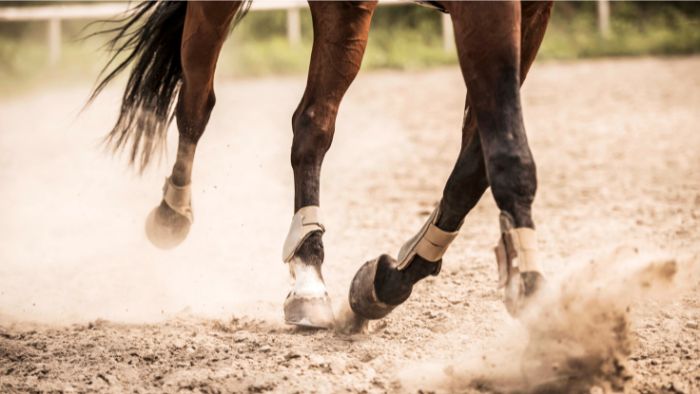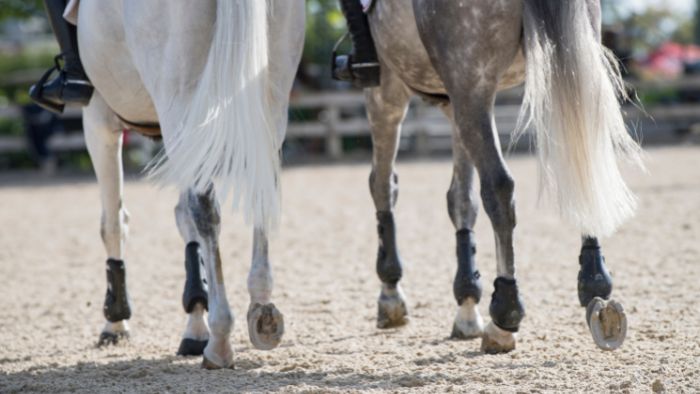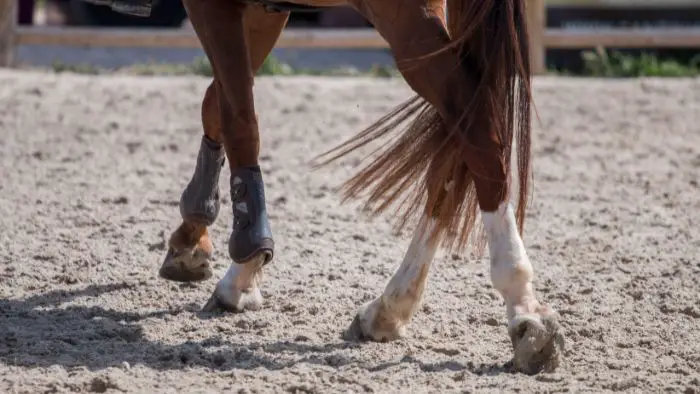Last Updated on July 14, 2022 by Guillermina
Seeing your horse running from behind will give you a clear view of their leg muscles. If this picture doesn’t look how you’d like it to, you’ll need to do leg exercises with your horse.
Horses are powerful and can perform excellently if they’re in top shape. In this article, I share why your horse needs strong hind legs and which exercises work best to strengthen these muscles.
Reasons Why Horses Need Strong Hind Legs
Horses need strong hind legs for several reasons. The hind legs are a source of power. They allow your horse to move forward and also maneuver and adjust quickly. Horses developed strong hind legs to escape from predators. Running is their primary defense.
Strong hind legs also make a massive difference during competitions. Weak hind legs can be the cause of losing at a very critical moment. Weakness in the hindquarters can also affect a horse’s performance. This can cause pain or soreness, affecting your horse’s speed.
Simple Exercises To Strengthen Your Horse’s Hind Legs
You can do some simple exercises to help your horse strengthen their hind legs. Here are some ideas:
Stretching
Stretching exercises keep your horse flexible and help them gain strength in their hind legs.
Start by stretching their hind leg forward as if you’re trying to touch their opposite front leg with their hoof. Then pull their hind leg back as if you’re cleaning their hoof. This is the safest way to stretch your horse’s leg backward.
For the next stretch, pull your horse’s leg up under their hip, flexing their stifle and hock. This stretch is called a high flexion stretch.
The last stretch used is the carrot stretch. With this, you should offer your horse a snack encouraging them to stretch backward.
Hold each stretch for 20 to 30 seconds. If your horse has trouble holding the stretch, start with shorter periods until they manage longer times.
But Tucks
When standing off to one side behind your horse, scratch your nails down their rump, next to the muscle crease. Doing this will encourage your horse to tuck their tail and round their back. Encourage your horse to hold this butt tuck for at least 30 seconds. Repeat this exercise 10 times.
Tail Pulls
To perform a tail pull:
- Stand by your horse’s side and grab onto their tail.
- Pull their tail sideways in a strong and steady action.
- Hold this pull for ten seconds and repeat ten times.
Backing
Start this exercise by allowing your horse to back up in a straight line. Use a slow and steady pace. It’s best to perform this exercise on a gentle incline to challenge your horse and really work their hindlegs.
Ground Poles
Riding over ground poles is a great way to encourage your horse to lift their legs. This exercise engages their hindquarter muscles for a better range of motion and ground clearance. You can also raise the poles for jumping. Doing this will increase muscle strength in their hindquarters.
Seeing A Horse Running From Behind: This Is How It Should Look
When looking at your horse from behind, watch the movement of their bottom and hips. Especially when they’re running.
Their muscles should be flexible and show their leg movements clearly. You should be able to see their muscles’ strength as your horse moves. Muscles should be well defined and not hard. Hard muscles are weak.
Strong back legs shouldn’t cause the hocks to sway. Your horse’s hips shouldn’t drop when they’re walking. Any one of these signs may indicate soreness or weakness. If these happen, a call to the vet is needed to rule out illness or injury.
Tips To Keep Your Horse’s Hind Legs Fit
Keeping your horse’s hind legs fit is easy if you add some stretches and workouts to your exercise routine. Work in increments to increase your horse’s stamina and overall fitness level.
Only start an exercise routine with the approval of your vet. Keep in mind that any new or increased exercise may cause soreness. You need to ensure your horse gets enough time to rest their sore and aching muscles. Remember to protect their legs and feet from injury.
You can add stretches and climbing to your regular workout routine. Always start with a warm-up routine and end with a cool-down routine. Weak muscles strengthen with regular exercise. Remember to let your horse rest between each set of exercises. You may also want to increase the number of days you exercise.
Remember that your horse will respond better to a new exercise routine if they receive the proper treatment they need for an injury or illness causing weakened back leg muscles.
Wrapping Up
If your horse has strong hind legs, they’ll run faster, jump higher, and effortlessly outshine their competition. Even if your horse doesn’t participate in shows, having strong hind legs will help them work more efficiently and be a worthy investment.
Horses also have big bodies to keep upright and carry. With strong hind legs, this task is easier.
I hope you enjoyed this article and have the info you need to strengthen your horse’s hind legs. If you have unanswered questions, ask them in the comments, and I’ll respond!
FAQs
What is the best age of a horse to buy?
If you don't have any equine experience, you should buy a horse aged 5 to 16. This is when they're in their prime and typically have training.
What breed of horse is best for beginners?
Morgan and Friesian breeds are best for beginners. While any horse breed can be tamed, these are typically the easiest to work with.
What height of a horse is right for me?
You can determine the height of the horse you need by calculating your inseam to their height. Your inseam should be 60% or less of your horse's height in inches.
How do I pick my first horse?
There's no right way to pick your first horse, and many people rely on a gut feeling. Just look for one with training that's well-mannered.



